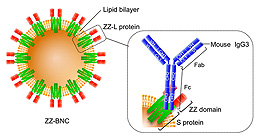Research Abstract
高速原子間力顕微鏡法による免疫センサー上の整列固定化IgGのナノレベル可視化
Nano-visualization of oriented-immobilized IgGs on immunosensors by high-speed atomic force microscopy
2012年11月9日 Scientific Reports 2 : 790 doi: 10.1038/srep00790

センシング分子を固相上に整列させて固定化することは、バイオセンシングの重要な課題である。免疫センサーにおいて、溶液中の免疫グロブリンG(IgG)の方向性および形状だけでなく、IgGのリアルタイムな動きを精査することも重要であるが、既存の技術では両者を同時に達成できない。最近我々が開発したバイオナノカプセル(BNC)は、黄色ブドウ球菌プロテインAのIgG-Fc結合Zドメイン2量体を表面に提示しており(ZZ-BNC)、免疫センサー上のIgGを整列化させ抗原検出感度および抗原結合能を上昇させることができる。今回我々は、高速原子間力顕微鏡(HS-AFM)を用いて、ZZ-BNCの微細な表面構造を明らかにし、溶液中でZZ-BNCにつなぎ止められたマウスIgG3分子の動きを観察した。その結果、ZZ-BNCはIgGの整列化の足場として働き、IgGのFv領域はブラウン運動により回転していることが明らかにされた。したがって、HS-AFMは、バイオセンサー上のセンシング分子のリアルタイムな動きを1分子レベルで明らかにすることが可能であり、今後のバイオセンサー開発において重要な解析手段と言える。
飯嶋 益巳1, 曽宮 正晴1, 良元 伸男1, 新美 友章1 & 黒田 俊一1
- 名古屋大学大学院 生命農学研究科 生命技術科学専攻 生物機能技術科学講座 産業生命工学研究分野
Oriented immobilization of sensing molecules on solid phases is an important issue in biosensing. In case of immunosensors, it is essential to scrutinize not only the direction and shape of immunoglobulin G (IgG) in solution but also the real-time movement of IgGs, which cannot be achieved by conventional techniques. Recently, we developed bio-nanocapsules (BNCs) displaying a tandem form of the IgG Fc-binding Z domain derived from Staphylococcus aureus protein A (ZZ-BNC) to enhance the sensitivity and antigen-binding capacity of IgG via oriented-immobilization. Here, we used high-speed atomic force microscopy (HS-AFM) to reveal the fine surface structure of ZZ-BNC and observe the movement of mouse IgG3 molecules tethered onto ZZ-BNC in solution. ZZ-BNC was shown to act as a scaffold for oriented immobilization of IgG, enabling its Fv regions to undergo rotational Brownian motion. Thus, HS-AFM could decipher real-time movement of sensing molecules on biosensors at the single molecule level.

